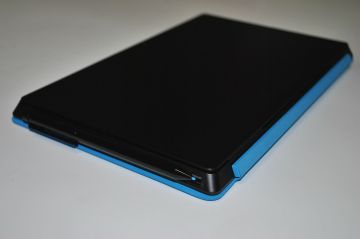Ever since Microsoft released Windows 8, I’ve been waiting for a device with just the right combination of tablet-like portability and laptop-like power. A year later, and I’m still waiting.
But on Tuesday, I caved and picked up a Surface Pro 2 with 256 GB of storage. It is not the hybrid of my dreams — ideally, I want a slightly larger screen and more battery life, and at $1430 with a Type Cover it was more money than I’d hoped to spend — but I’m not sure if such a device will exist anytime soon. And despite the lukewarm reviews of the Surface Pro 2, which are generally hesitant to recommend the device to everyone, I’m hoping it’ll be a good fit for me.
Here are a some reasons why I settled on the Surface Pro 2:
Half Working, Half Relaxing
I use a desktop PC for work during the day, but my work doesn’t always end there. In the evenings, I may still do some writing, research or e-mailing on a laptop — most likely my Samsung Series 5 550 Chromebook.
But what happens is that even when I’m not doing work, I end up staying on my laptop for things like reading and checking Twitter. Curling up with a laptop isn’t ideal, but it’s easier to stick with it than to switch back and forth between devices. Having something that can become a tablet makes sense, and the Surface is arguably better at it than a larger convertible device like the Lenovo Yoga.

Windows By Process of Elimination
Plenty of people now use iPads for light work, but it’s not ideal for me. I need a mouse or trackpad for precision uses like image editing, and for quickly accessing context menus such as “open in new tab” in the browser. There are some Android hybrids with trackpads, but the operating system isn’t really built for cursor use. I could get another Chromebook, but I’d rather not have another machine that can’t access desktop software such as LiveScribe, LibreOffice and HipChat. That leaves Windows and Mac, and Windows is the only one that’s even attempting hybrid devices right now. (Apple CEO Tim Cook disapproves of the concept.)
Besides, there’s one other Windows perk that pushed me over the edge: I have a sizeable PC game library in Steam. The Surface Pro 2 won’t run every game, but it should be adequate for lighter and older games. I’m looking forward to plugging in an Xbox 360 controller, propping up the kickstand and getting some gaming in.
Filling the Void with a Smaller Tablet
Though I wouldn’t buy the Surface Pro 2 as my only tablet due to its lack of apps and chunkier build, I see it as a good complement to a smaller, less expensive device like the iPad Mini. After using tablets both large and small, I find it easier to cradle a smaller screen in one hand while reading, or to reach all parts of the screen with my thumbs while gaming. If I’m going to get a larger device along with it, I’ll want more power beyond what the iPad offers.
Along that line, the added weight and thickness of the Surface Pro 2 doesn’t really bother me. Larger tablets usually end up on my lap anyway because it frees up both hands to touch the screen. The bulky Surface 2 isn’t really a burden when you’re not holding it up, plus it has the kickstand to help free up those hands even further.
A Little Complexity Is Okay
I’ve seen plenty of complaints that Windows 8 adds complexity by squishing two operating systems together, but I’m okay with that. I enjoy venturing into the modern side of Windows 8.1 for full-screen apps like Twitter and Latermark (a free Pocket client for offline reading), and retreating to the classic desktop for programs like Chrome and Steam. I even use the two sides together, keeping Twitter or Mail in Snap view while typing a document on the desktop.
Reservations Remain
Despite all those reasons for getting a Surface, I still have some hesitations about it.
The screen is smaller than most laptops, which makes me worry about eyestrain. Because the screen is small, so is the trackpad on the matching Type Cover, and the felt material is no match for the glass trackpad of a proper laptop. So far I’ve also noticed some general nitpicks with the trackpad, such as some fussy two-finger scrolling in certain apps. I’m not keen on the idea of connecting a mouse to just correct the trackpad’s shortcomings.
My other big concern is battery life. While it’s much improved over the first Surface Pro, it’s still no match for a traditional tablet. In my mixed use today, I didn’t even make it to six hours on a charge. The Power Cover keyboard is an option when it comes out next year, but that’s another $200, and it adds a lot more weight to the package.
With all that said, I’ll be spending the next few weeks making the Surface Pro 2 part of my daily computing routine, and ultimately deciding whether to take advantage of Microsoft’s 30-day return policy. As I purchased the Surface Pro 2 on Tuesday, I had two Microsoft Store employees insist, “You’re going to love it.” Given the price, I’d better.

